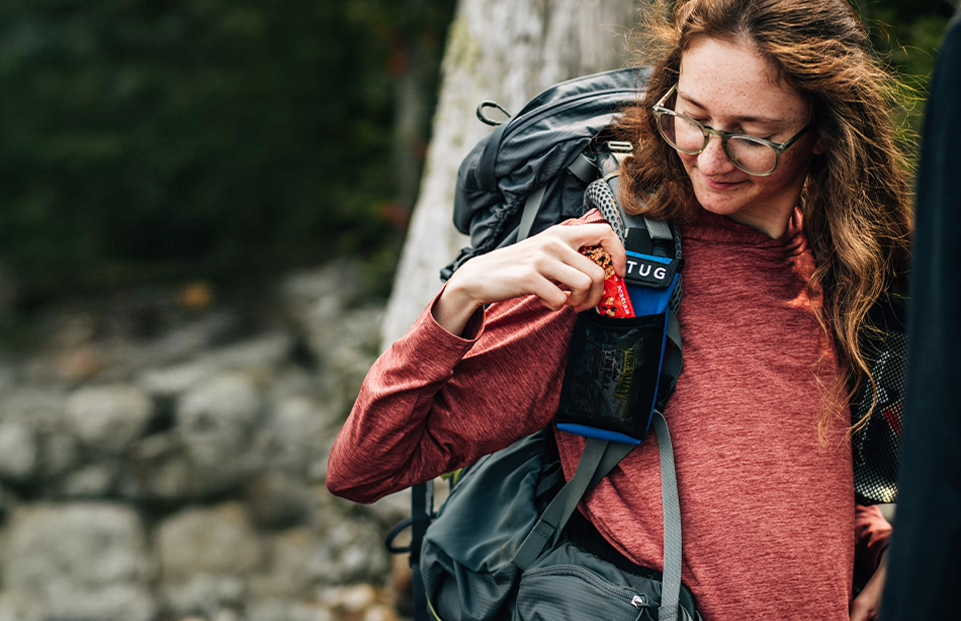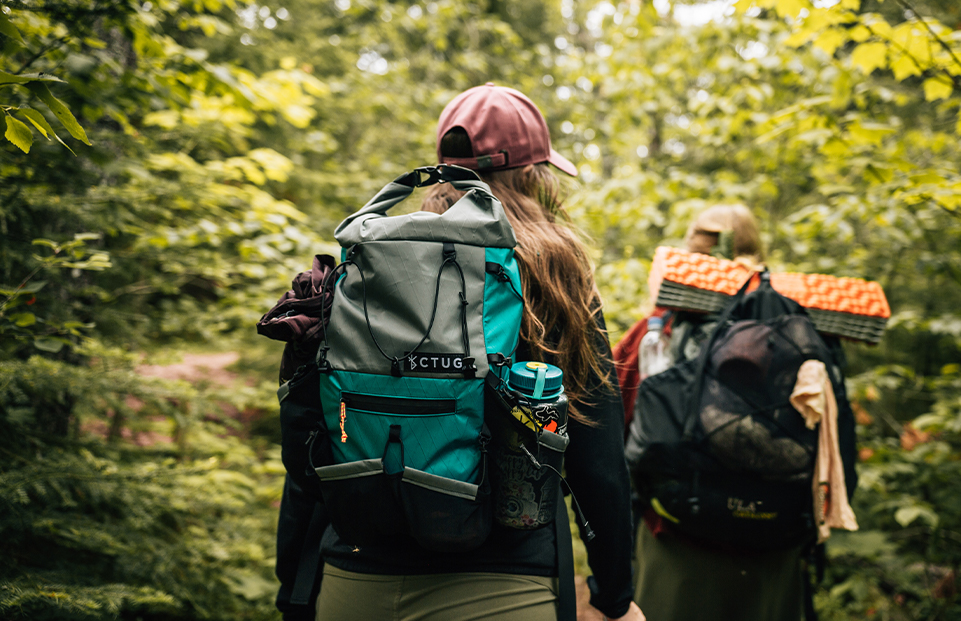Hiking can feel intimidating when you’re just starting out, but it doesn’t have to be. If you have a can-do attitude, proper footwear, and a few minutes to read this post, you’ll be well on your way. The great outdoors—and our top 15 tips—await!
Hiking Gear for Beginners
1. You need proper clothing and footwear
You must make sure you’re wearing proper clothing for your initial hiking adventure. For many newbie hikers, this is their first mistake.
Although you don’t need to invest in top-of-the-line hiking pants or crampon-compatible boots from the get-go, you do need to have moisture-wicking attire that’s easy to move in.
Do not wear jeans or cotton leggings! These items don’t dry fast enough when they get wet from sweat or moisture, which can cause chaffing or chills. Cotton is also a no-go for similar reasons. Instead, you need clothing made from quick-drying fabrics like wool or polyester.
You should also have a warm layer (like a puffy vest fleece pullover) and a rain jacket. Even if you don’t think you’ll need it, better to be prepared than to freeze your butt off with some unexpected wind!
For footwear, a good pair of trail runners, or hiking shoes will do the trick for most beginner hikes. We recommend Hokas, Brooks or Altras! Of course, you can also wear hiking boots if you need a little more ankle support. Just be aware that new boots can cause blisters at first.
2. Use a functional backpack
You need to carry water, snacks, and a first aid kit. A small backpack is ideal for shorter hikes. It also means that you’ll have somewhere to store extra layers when you don’t need them.
Try to find a backpack that has a chest strap and waist strap since this helps distribute the weight, making the bag more comfortable to wear. You’ll be grateful for those features when you start doing longer hikes!
Also, consider where you can store your phone during your hike. Having your phone within reach is extremely beneficial for both navigation and safety. We recommend using a phone pouch that attaches to the shoulder strap of your backpack, like our popular Shoulder Strap Phone Pocket or CTUG Fanny Pack!
3. Have a water system
Whenever you head out for a hike, you need to have enough water. Dehydration is a serious hazard and can come on quickly, particularly during hot summer hikes. We suggest a reusable water bottle.
You should aim to carry 250 ml of water for every hour of hiking in moderate temperatures. We also recommend bringing a water filter for those longer hikes!
4. Make a first aid kit
Accidents can happen, even on well-trafficked, beginner trails. Make sure you bring a first aid kit with you to deal with any injuries, scratches, bug bites, or sprains. Additionally, it doesn’t hurt to have safety equipment like a flashlight, whistle, bear spray, and lightweight space blanket for an emergency shelter, depending on where you’re hiking and how long your trip is!
Choosing a Hike
5. Use websites and apps to find trails
Next, it’s time to select a hike. You can use websites (like hiking blogs or park websites) and apps (like AllTrails or Gaia GPS) to find hikes in your area. There is no shortage of trails, so narrow down your options by searching for your preferred difficulty (easy to moderate), distance, and elevation gain.
6. Research the hike
Make sure that the hike is a good fit for your fitness level, experience, and time restrictions. How long is the hike? Are you comfortable walking that far, and do you have ample time to do so? What’s the elevation gain? The greater the elevation gain, the harder the hike.
In addition, check that the hike is accessible at the current time of year. Some trails have snow cover well into summer.
7. Download the trail for offline use
Once you’ve chosen a hike, download the trail for offline use on your preferred hiking app. This ensures that you have access to the trail (with distance and elevation data) and topographic map even without cell service. This isn’t just handy, it’s also important for safety!
Hiking Preparation
8. Pack the ten essentials
The ten essentials are just that—essential. You must carry these items with you in event of a minor injury, sudden weather change, or unexpected delay.
- Water
- Navigation (map, GPS system)
- Sun protection
- Warm layers
- Flashlights / Lanterns
- First aid kit
- Firestarter or lighter
- Food
- Repair kit and tools
- Emergency shelter
9. Learn the seven “Leave No Trace” principles
As hikers (no matter your experience), it’s our responsibility to protect the environments that we get to explore. That’s where the Leave No Trace (LNT) principles come in. These seven principles outline how to minimize our impact on the great outdoors. Learn about them here.
- Plan ahead and prepare.
- Travel on durable surfaces.
- Dispose of waste properly.
- Leave what you find.
- Minimize campfire impacts.
- Respect wildlife.
- Be considerate of others.
10. Prepare for wildlife
You can minimize the risk of unpleasant wildlife encounters with proper preparation and awareness. Before hitting the trails, research what wildlife lives there. Understand what to do if you see a black bear, grizzly bear, elk, moose, or rattlesnake.
Do not try to turn your encounter into an Instagram moment. That’s how people get hurt. Give all wild animals ample space. In bear territory, you must carry bear spray.
11. Check the weather forecast
If you’re hoping to hike in the next week or two, take a look at the long-term weather forecast. Of course, the forecast will likely change before then! Nonetheless, it’s useful to have an idea of what’s coming so you can schedule your hike accordingly.
Before You Hike
12. Wear appropriate clothing
As you dress for your hike, layers are essential. It should be easy to take layers off (and put them back on again) as needed. In cool temperatures, your next-to-skin base layers should be wool or a moisture-wicking polyester that will keep you warm even as you sweat.
Meanwhile, in summer, breathable fabrics will help keep you cool. Even if it’s hot and dry, pack warm layers and rain wear just in case. Weather can change quickly, especially in the mountains.
13. Share your plan with someone you trust
Every time you embark into the great outdoors for an adventure, you need to have a check-in back in civilization. This is vital for safety, especially if you’re hiking solo. Tell someone you trust where you’re going, what hike you’re doing, when you’re leaving, and when you expect to be back.
14. Check the weather…again
You really can’t check the weather often enough. However, definitely take a look at the forecast the day before and the day of your hike. Make sure to check the weather at your goal elevation as well! Reschedule for another, drier day if the conditions have changed and are no longer favourable.
15. Start early
Starting early has a few major advantages. First, it’s the best way to beat the crowds. Second, it gives you maximum time for your hike. That way, you’ll have plenty of daylight if your hike ends up taking longer than you anticipated.
It takes a few hikes to get a sense of your pace, so always give yourself more time than you think you need at the beginning of your hiking journey.
Consider the Chicken Tramper Ultralight Phone Pouch for Hiking Backpacks
There you go: you’re ready to hit the trails, breathe in that fresh air, and get your daily dose of nature. All that’s left to do is lace up your shoes and tuck your phone into the Chicken Tramper Ultralight Phone Pouch.
Remember, having your phone readily available makes it easier to check your navigation and check-in with your contact back home. Happy trails!
To learn more about our Ultralight Phone Pouch, reach out to Chicken Tramper Ultralight Gear at info@chickentrampergear.com.



